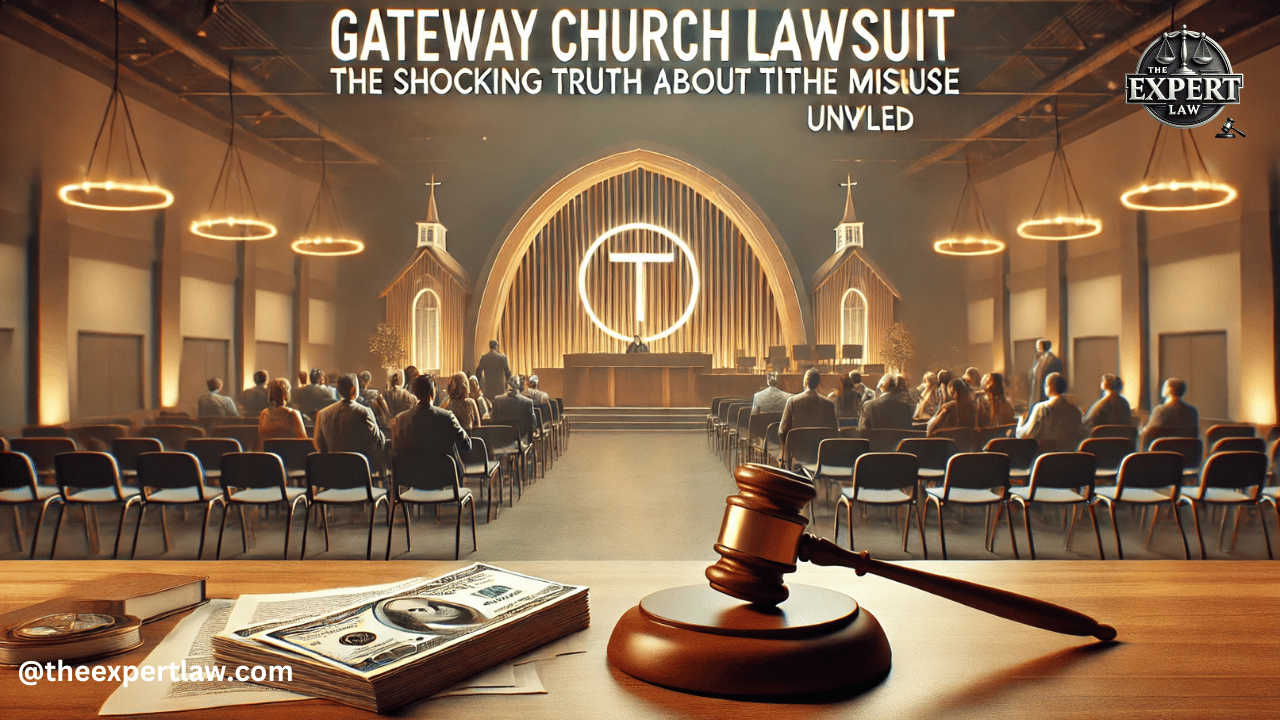Introduction
Gateway Church has long been recognized as a beacon of faith, attracting thousands of individuals who share a deep spiritual connection. Located in Texas, this prominent church is celebrated for its vibrant community and heartfelt teachings. One of the foundational practices within Gateway Church, as in many religious institutions, is tithing—a tradition rooted in biblical principles where members contribute a portion of their income to support the church’s mission. For many, tithing symbolizes trust in God and commitment to a shared spiritual journey, fostering a sense of purpose and unity among the congregation.
However, recent events have shaken this trust. A lawsuit has emerged that questions the very foundation of how Gateway Church handles its tithes. Allegations suggest that funds meant for charitable and global mission purposes were misused, leaving many in the community feeling betrayed. This case has not only raised legal concerns but also emotional and spiritual ones, as members grapple with doubts about their contributions’ impact and integrity.
The allegations have sparked widespread discussions, both within and beyond the church’s walls, about financial transparency and accountability in religious organizations. It’s a story that blends faith, trust, and responsibility, offering insights into the delicate balance between spiritual devotion and practical stewardship. Let’s explore the details behind this controversy and its broader implications for the community.
Background of Gateway Church
Gateway Church began its journey in 2000, founded by Pastor Robert Morris in Southlake, Texas. With humble beginnings in a living room with just a few families, the church rapidly grew into one of the largest and most influential congregations in the United States. Today, Gateway boasts multiple campuses across Texas, a thriving online ministry, and tens of thousands of members who actively participate in its spiritual and social initiatives. Its focus on community connection, modern worship experiences, and impactful sermons has made it a cornerstone for many seeking a deeper relationship with God.
The church’s growth can be attributed to its dynamic leadership and visionary approach. Pastor Robert Morris, known for his engaging teaching style and relatable messages, remains the face of Gateway Church. His teachings often emphasize generosity, faith, and practical ways to live out biblical principles. Alongside Pastor Morris is a well-structured leadership team, including senior pastors, financial officers, and administrative leaders, who oversee the church’s operations and ministry efforts.
Gateway’s success has also been shaped by its commitment to outreach and global missions. The church has consistently aimed to serve not only its local community but also international causes, with promises to allocate a significant portion of its funds, including tithes, to support charitable endeavors. This emphasis on giving has been a central theme in Gateway’s identity, fostering a culture of trust and generosity among its members.
However, this trust has been tested by recent allegations, which claim that some of these funds were not used as intended. These claims have put the spotlight on the church’s leadership structure and financial practices, raising questions about whether its meteoric growth may have come with challenges in maintaining transparency and accountability. Despite these concerns, Gateway’s history reflects a story of faith, growth, and the power of community, making the current situation all the more impactful for those who call it their spiritual home.
Allegations of Tithe Misappropriation
In October 2024, a group of Gateway Church members filed a class-action lawsuit, accusing the church of misusing tithes. They claim that the church promised to allocate 15% of all tithes to global missions and Jewish ministry partners but failed to do so.
The plaintiffs allege that, despite the church’s annual revenue exceeding $100 million, only about $3 million was directed toward global missions each year—far less than the promised amount.
One of the plaintiffs, Katherine Leach, expressed her disappointment, stating that the lawsuit was a last resort due to the church’s lack of transparency. She emphasized that members trusted the church to use their tithes as promised and felt compelled to seek answers when that trust was broken.
Financial Promises and Discrepancies
Gateway Church has long emphasized generosity as a cornerstone of its mission, publicly pledging to allocate 15% of all tithes to global missions and Jewish ministry partners. This promise resonated with the congregation, encouraging members to give with the assurance that their contributions would make a significant impact on international humanitarian and evangelical efforts.
However, allegations and findings suggest discrepancies between these commitments and the actual allocation of funds. Reports from internal audits and whistleblowers, including statements from former financial officers, have painted a troubling picture. While the church’s annual revenue surpasses $100 million, records reportedly show that only around $3 million annually has been directed toward global missions. This figure falls significantly short of the 15% promised, raising questions about where the remaining funds were allocated.
Former financial officers have reportedly raised concerns internally about the church’s financial practices, claiming that a large portion of the tithes went toward operational expenses, new building projects, and leadership compensation. These revelations have fueled frustrations among members, many of whom feel their trust was violated.
The discrepancy between the promised and actual disbursements has become a central issue in the lawsuit. Congregants argue that their financial contributions were made in good faith based on the church’s stated goals. For them, the alleged misallocation not only represents a breach of trust but also undermines the mission-driven identity that Gateway Church has cultivated over the years.
Leadership Response and Internal Investigations
Gateway Church’s leadership has responded to the allegations with a mix of denial and commitment to transparency. In official statements, the church has expressed its dedication to its mission and emphasized that it takes the concerns of its members seriously. They have denied any intentional wrongdoing, attributing the discrepancies to misunderstandings about how funds are allocated and managed.
To address the growing concerns, the church announced that it would take steps to ensure financial transparency. These steps include engaging external auditing firms to conduct an independent review of its financial practices. The leadership has also pledged to make the findings of these audits available to the public, demonstrating their willingness to be held accountable.
In the wake of the lawsuit, there have been significant leadership changes within the church. Reports indicate that some senior officials, including those responsible for financial oversight, have stepped down or been reassigned. These resignations have been framed as a way to restore trust and show the church’s commitment to addressing the issues raised by the lawsuit.
The church has also created a task force to review its policies on tithing and fund allocation. This team, comprising both internal leaders and external advisors, aims to implement more robust measures to prevent similar situations in the future. While these efforts signal a step toward rebuilding trust, many members remain skeptical, awaiting tangible results and clarity on how their contributions are being used.
The leadership’s response highlights the challenges of navigating a crisis that touches both financial and spiritual aspects. For the church, this moment represents an opportunity to not only address the allegations but also rebuild the faith of its community by proving its commitment to integrity and transparency.
Legal Proceedings and Developments
The lawsuit against Gateway Church has quickly become a focal point for discussions about financial transparency in religious organizations. The legal proceedings began when a group of church members, frustrated by unanswered questions about the use of their tithes, filed a class-action lawsuit. Here’s a look at how the case has unfolded and its potential impact.
Timeline of the Lawsuit
The lawsuit was officially filed in late 2024, alleging misappropriation of funds intended for global missions. The initial filing outlined specific claims of financial discrepancies and included detailed accounts of how church leaders allegedly failed to fulfill their promise of allocating 15% of tithes for missions. As the case gained public attention, additional members came forward to share their concerns, expanding the scope of the lawsuit.
Key legal milestones so far include:
- Filing of the Lawsuit: Members formally accused the church of breaching trust by mismanaging funds.
- Initial Court Hearings: Early hearings have focused on establishing the validity of the claims and collecting evidence.
- Request for Financial Records: Plaintiffs’ attorneys have sought comprehensive financial disclosures from the church to support their case.
- Church’s Counterarguments: The church has argued that the claims are based on misunderstandings and disputes the allegations of intentional misconduct.
Responses from the Defendants
Gateway Church leadership, named as defendants in the case, has categorically denied any wrongdoing. In public statements and court documents, they have asserted that all funds were used appropriately and in alignment with the church’s mission. They have also emphasized that tithing contributions are not legally enforceable promises but spiritual commitments, implying that the lawsuit may lack legal merit.
The defense has also pointed out the complexity of managing such a large organization, stating that allocation decisions are influenced by many factors, including operational needs and unforeseen circumstances. Nevertheless, they have promised to cooperate fully with the investigation and demonstrate their commitment to financial accountability.
Potential Implications for the Church and Its Leadership
The lawsuit poses significant challenges for Gateway Church, both legally and reputationally. If the plaintiffs succeed, the church could face financial penalties and be required to implement stricter oversight of its funds. This could lead to more comprehensive reforms in how religious organizations manage and report their finances.
For church leadership, the implications are equally profound. The allegations have already led to leadership changes, and a loss in court could result in further resignations or restructuring. The case has also strained the relationship between the church and its members, with many questioning whether they can continue to trust the institution.
Beyond Gateway Church, this lawsuit could set a precedent for how financial disputes in religious organizations are handled. A ruling in favor of the plaintiffs may encourage other congregants in similar situations to demand greater accountability, potentially reshaping the broader landscape of church governance and financial transparency.
Congregational Impact and Reactions
The allegations of financial mismanagement at Gateway Church have deeply affected its congregation and the surrounding community. The lawsuit has sparked a mix of emotions—anger, betrayal, sadness, and a deep sense of uncertainty—among those who once placed unwavering trust in the church’s leadership. For many, the issue goes beyond finances; it feels like a personal and spiritual violation.
Reactions from Church Members and the Broader Community
Many members have expressed their disappointment and shock upon hearing the claims. For years, they believed their tithes were supporting global missions and humanitarian causes, reflecting the values they cherished. Now, the idea that these funds may not have been used as promised has left some questioning their role in the church.
The broader community has also taken notice, with some seeing the lawsuit as an opportunity to address long-standing concerns about financial accountability in large religious organizations. Others, however, view it as an attack on faith-based institutions, causing division even outside the church’s immediate circle.
Social media platforms and community forums have become outlets for members and critics to voice their opinions. Supporters of the church urge patience and await the results of investigations, while others demand immediate answers and accountability.
Impact on Church Attendance, Donations, and Member Trust
The lawsuit has had a visible impact on Gateway Church’s operations. Attendance at services has reportedly declined, with some members choosing to step back until the allegations are resolved. Donations have also decreased as members hesitate to give, unsure of how their contributions will be used.
Trust, which is fundamental to the relationship between a church and its congregation, has been significantly eroded. For many, tithing was an act of faith and trust in the church’s mission. Now, the controversy has left them feeling uncertain about whether their generosity truly makes a difference.
Personal Stories from Congregants Affected by the Controversy
Some congregants have shared their personal struggles in the wake of the allegations. Katherine, a long-time member, recounted how she diligently tithed despite financial hardships, believing her contributions were helping those in need. She described her heartbreak upon learning that funds might not have been used as intended.
Others have shared stories of feeling torn between their faith and the church’s actions. For many, Gateway Church has been a spiritual home, a place of comfort and community. The controversy has left them grappling with whether to stay and hope for reform or to seek a new place of worship.
Amidst the division, there are also members who have chosen to stand by the church, citing their belief in forgiveness and the importance of addressing mistakes without abandoning the community. These members hope that the lawsuit will ultimately lead to greater transparency and a renewed sense of purpose for Gateway Church.
The impact of the lawsuit is undeniably profound. It has challenged not just the leadership but also the congregation’s faith and unity, forcing members to confront difficult questions about trust, accountability, and their role in the church’s future. For now, the journey ahead is uncertain, but it holds the potential for healing and transformation if approached with honesty and care.
Walgreens Lawsuit Claim: The Shocking Truth Behind Major Legal Battles and What It Means for You
Broader Implications for Church Financial Transparency
The Gateway Church lawsuit has highlighted a critical issue: financial transparency in religious institutions. As places of worship rely heavily on the trust and generosity of their members, maintaining clear and honest financial practices is vital for preserving that trust. This controversy serves as a wake-up call for churches worldwide to reevaluate how they manage and communicate their financial operations.
The Importance of Financial Transparency in Religious Institutions
Religious organizations are unique in that their funding is often rooted in faith. Members give not just to support day-to-day operations but also to further spiritual missions, charitable endeavors, and global outreach. This creates an unspoken contract: members give with the understanding that their contributions will be used ethically and effectively.
When transparency is lacking, it can erode trust, leading to doubts about leadership integrity and the church’s mission. For many, the act of giving is deeply personal, and any misuse of funds can feel like a betrayal. Transparent practices, such as detailed financial reporting and regular audits, not only reassure members but also demonstrate accountability to a higher standard, reflecting the values many religious institutions aim to embody.
Comparative Analysis with Similar Cases
The Gateway Church lawsuit is not an isolated incident. Other large churches have faced similar allegations of financial mismanagement. For instance, in recent years, cases involving megachurches in the U.S. have revealed patterns of excessive spending on leadership perks, lack of clarity in fund allocation, and limited oversight.
One prominent example involved a church accused of using tithes for luxurious expenses, such as private jets and high-end real estate. In another case, funds meant for missions were redirected toward promotional campaigns. These instances not only tarnish the reputation of the institutions involved but also fuel broader skepticism about religious organizations as a whole.
By comparing these cases, one common thread emerges: the absence of robust checks and balances. In many instances, internal decision-making lacks independent oversight, creating opportunities for mismanagement or even abuse of funds.
Lessons Learned and Recommendations for Best Practices
The Gateway Church lawsuit, alongside similar cases, offers valuable lessons for religious institutions:
- Adopt Transparent Financial Practices: Churches should regularly publish detailed financial reports, clearly showing how tithes and donations are being used. Transparency builds trust and assures members that their contributions align with the church’s mission.
- Implement Independent Audits: External audits by reputable accounting firms can provide unbiased assessments of a church’s financial health and practices, ensuring accountability.
- Establish Oversight Committees: A financial oversight board, comprising members of the congregation and independent advisors, can help monitor fund allocation and provide an additional layer of accountability.
- Communicate Regularly with the Congregation: Leaders should maintain open channels of communication, sharing updates on how funds are being used and celebrating the impact of contributions.
- Prioritize Ethical Stewardship: Beyond legal obligations, churches must hold themselves to the highest ethical standards, reflecting the trust and faith placed in them by their members.
Conclusion
The Gateway Church lawsuit regarding tithe mismanagement serves as a critical reminder of the delicate balance between faith and accountability. For members, tithing is more than just a financial contribution—it’s an act of devotion and trust. Allegations of misuse challenge not only the church’s integrity but also the deep spiritual connection many have with their faith community.
This controversy has brought to light the importance of financial transparency in religious institutions. Whether through independent audits, clear communication, or robust oversight structures, churches must prioritize accountability to honor the trust placed in them by their congregants. While the legal proceedings continue, this moment represents an opportunity for Gateway Church—and religious organizations everywhere—to rebuild trust and reinforce their commitment to ethical stewardship.
For those affected, this journey has been challenging, filled with disappointment and tough questions. Yet, it also opens the door for reflection, growth, and the hope that the lessons learned will lead to stronger, more transparent faith communities in the future.
References
- CBS News Texas. “Gateway Church Members File Lawsuit Over Alleged Misuse of Tithes.”
Read the full article here - The Roys Report. “Lawsuit Accuses Gateway Church of Misusing Members’ Tithes.”
Read the full article here - Official Statements from Gateway Church Leadership (2024). Available on the church’s website.
- Class Action Court Documents Filed in October 2024. Available through public legal records.
Dive into the world of laws with The Expert Law. Visit our website and unlock endless inspiration!





